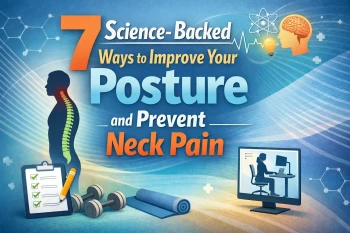
Can Cervical Spinal Stenosis Be Cured?
Cervical spinal stenosis is a condition found mostly in adultsages 50 and older. This condition is when the spinal canal in theneck begins to narrow which causes pain and other issues to arise.Cervical spinal stenosis is most caused by arthritis but could becaused by herniated discs, injuries, tumors, and Paget’s disease (acondition in which bones grow abnormally large and brittle).
How Dangerous is Cervical SpinalStenosis?
Cervical spinal stenosis can squeeze and compress the nerveroots as the spinal canal narrows or compress or damage the spinalcord. The nerves that are squeezed can change how your spinal cordfunctions and cause numbness, weakness, stiffness, or pain to occurin the neck, arms, and legs. This compression of the nerves couldalso affect your bladder, bowels, and other bodily functions.
Because cervical spinal stenosis compresses your nerves, you mayhave trouble with gait and balance, grip strength, and dexterity.It is also recommended that those with cervical spinal stenosis donot partake in high impact exercises such as jogging and contactsports.
Is Cervical Spinal StenosisProgressive?
Over time, cervical spinal stenosis can worsen and do even moredamage to the body if it is left untreated. However, cervicalspinal stenosis does not always get worse over time or causeprogressive symptoms. There are many people who have mild stenosiswho do not have symptoms that are bothersome enough for them toseek treatment, but even though symptoms may not be bothersome itdoes not mean treatment should not be considered. Anything canhappen be it an accident or injury that can cause the condition toworsen suddenly if it is left unhandled.
In addition, the body itself can be undergoing changes you areunaware of because of this condition. If cervical spinal stenosisaffects your nerves, especially since the cervical area is wherethe brain stem is located, it can lead to distortion within thebrain to body communication. When this happens, the body is at abelow-average performance when it comes to fighting off infections,diseases, and healing or repairing itself.
Can Cervical Spinal Stenosis CauseDeath?
If cervical spinal stenosis is left untreated, it can causesignificant and permanent nerve damage; this includes paralysis anddeath.
What Type of Surgery Is Done for Cervical SpinalStenosis?
For those who have severe cervical spinal stenosis, surgerybecomes an option they may consider. Individuals who have severecervical spinal stenosis may struggle to walk or have trouble withtheir bladder and bowel.
Laminectomy and laminoplasty procedures are used to create spacebetween the bones to decrease inflammation. Laminectomy is the most common type of surgeryfor spinal stenosis while other options include the following:
- Laminectomy - This procedure involvesremoving the back part of the affected vertebra, called the lamina.Laminectomy is sometimes called “decompression surgery” as itreduces the pressure put on the nerves by creating space aroundthem.
- Foraminotomy - This is performed to lowerthe pressure by enlarging the passageway where a spinal nerve rootexits the spinal canal.
- Laminoplasty - This removes only aportion of the lamina usually by carving a hole just big enough torelieve pressure.
- Laminotomy - This is only performed onthe cervical spine – the vertebrae in the neck. In this procedure,space is opened within the spinal canal by creating a hinge on thelamina. The gap is bridged by metal hardware.
- Interspinous Process Spacer - This is aminimally invasive implant. The spacer is put between twointerspinous processes in the lower spine to increase the heightbetween them.
- MicroendoscopicDecompression - This procedure is minimallyinvasive, requiring a small incision to remove the pressure placedon the spinal cord and/or the nerve roots located in the spinalcolumn.
Does Cervical Spinal Stenosis RequireSurgery?
This depends on the severity of the case. Before surgery isconsidered, it is best to try more natural options as surgery isirreversible and bring about permanent, unnatural changes to yourbody. All surgery carries some type of risk such as infection,bleeding, and risks from anesthesia. When it comes to cervicalspinal stenosis, the surgery involved comes with a risk of damagingthe nerves, tearing tissue, chronic pain, and trouble passingurine.
Does Cervical Spinal Stenosis GetBetter?
Over time, cervical spinal stenosis typically gets worse. Therate at which it gets worse and how severe it can become alldepends on the person’s body and if they seek proper treatment.Upper cervical treatments can help cervical spinal stenosis bystunting its progress and has the ability to help your body healand repair itself from the damage it may have caused –naturally.
An upper cervical treatment is unlike general chiropractic. Anupper cervical chiropractor makes a gentle, extremely preciseadjustment to the upper cervical area of your spine (your neckarea). The top two bones of your spine that are located in thisarea protect your brain stem and when the spine is not alignedproperly, it can cause your vertebrae to press up against yourbrain stem causing you discomfort and complications with bodilyfunctions.
An upper cervical adjustment releases the pressure placed onyour brain stem to give back proper brain to body communication.With proper brain to body communication, the body can begin to healand repair itself as normal and help mend your spine to betterhealth. After an upper cervical adjustment, it is very common fordiscomfort and symptoms to go away over time without theinvolvement of medication or surgery.
Can Cervical Spinal Stenosis GoAway?
The severity of cervical spinal stenosis differs from patient topatient, as well as how much their body can heal and repair itselfafter an upper cervical treatment. Patients have seen improvementin their condition as early as their first adjustment. This isbecause of the brain stem’s power of your brain to bodycommunication being restored!
When the communication is disrupted, the body can begin toattack healthy cells as the signals can become misinterpreted.Patients with an upper cervical misalignment have also reported asignificant decrease or elimination of their discomfort and paindue to signals being sent through the body indicating pain whenthere is nothing causing the pain. In addition, signals can end upnot being sent at all, allowing foreign substances to freely roaminside of your body to cause further damage. This can do a lot ofdamage to different parts of your body, including your spine.
Upper cervical treatments are vital to keeping a healthy brainstem and brain to body communication. If you have an upper cervicalmisalignment, it could be rather difficult for the body to getbetter from cervical spinal stenosis if the communication stilldoes not allow you to heal, repair, and continue to damage itself.This misalignment can increase the severity of your cervical spinalstenosis as well as speed up the process in getting worse.
Patients have reported improvement to their cervical spinalstenosis with upper cervical alignments, an all-natural treatmentwithout the symptoms and additional complications that could arisefrom medication and surgery. If you are battling against cervicalspinal stenosis, allow upper cervical to help your body becomestronger while eliminating as much damage as it can with apossibility of stopping or reversing its progress before committingto more extreme options with side effects.
Patients who have already had medication or surgery have alsoseen great improvement in their cervical spinal stenosis afterupper cervical treatments due to their body tackling the cause oftheir condition rather than the symptoms.
We would like to invite you to accept our invitation fora free 15-minute phone consultation to speak with one of ourupper cervical chiropractic doctors where you can ask anyquestions you may have and decide if an exam or care might beright for you.
If you are interested, you can call ouroffice at (843) 225-5855.






Leave a comment